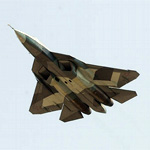Third PAK FA jet joined flight test program

The third Advanced Tactical Frontline Fighter (PAK FA) performed its first flight today in Komsomolsk-on-Amur KnAAPO. The jet was piloted by honored test-pilot Sergey Bogdan. The jet spent about an hour in the air and landed at KnAAPO runway after successful and complete fulfillment of the flight assignment. Aircraft stability and power plant performance were checked during flight, the pilot noting reliability of all systems and equipment.
PAK FA performed its maiden flight on January 29, 2010, in Komsomolsk-on-Amur. In the beginning of March, 2011, the second fighter took into the skies. Today, both aircraft participate in ground and flight test trials. The aircraft was presented to the public for the first time on August 17, 2011 at MAKS-2011, International Aviation and Space Salon, in Zhukovsky. As for today, PAK FA performed more than 100 flights.
PAK FA program includes creation of the fighter, setting up its serial production and introduction into service by the Russian Air Force. PAK FA will allow to increase Russian Air Force combat potential, take aviation industry to new technical level and give momentum to scientific research development along with providing sufficient workload for all the defense industry enterprises occupied with PAK FA design and production.
PAK FA program is a high-priority UAC military aviation program developed by JSC “Sukhoi Company”, UAC subsidiary. It will enhance new materials and technology development and implementation, their high innovative potential allowing new generation jet creation.
Compared to previous generation fighters, PAK FA has a number of unique advantages: it combines strike aircraft and fighter functions. The aircraft is equipped with conceptually new avionics with “Electronic pilot” integrated function and advanced radar with active phase antenna array. It reduces pilot’s workload and allows him to concentrate on performing tactical tasks. On-board equipment allows to carry out data exchange in real-time mode both with ground control system and team members.
Composite materials and innovative technologies application, advanced aerodynamics and measures aimed at engine signature concealment resulted in unequalled low level of radar, optical and infrared signature.
It allowed combat efficiency increase both for aerial and ground targets around-the-clock in all type of weather conditions.